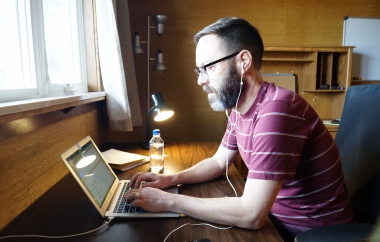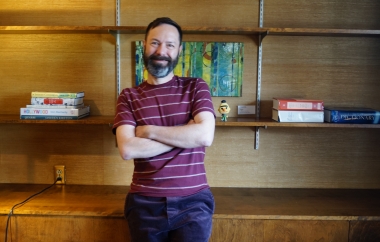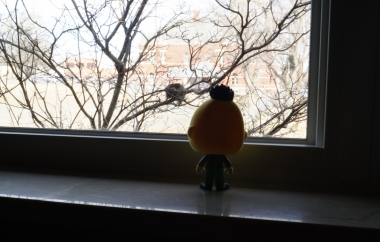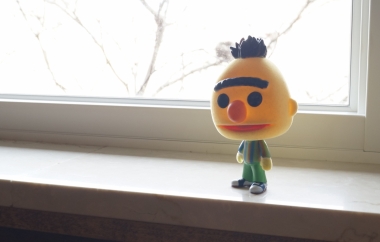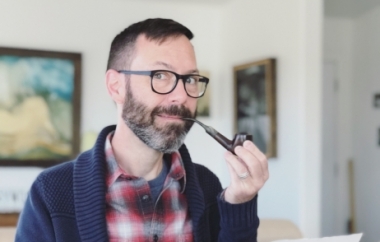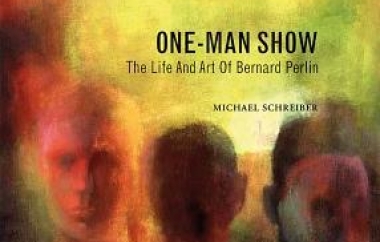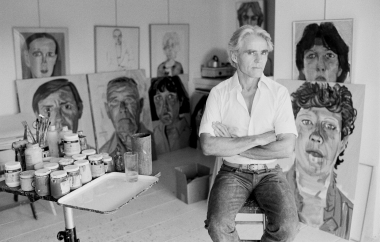Humans of KHN: Michael Schreiber
Humans of KHN: Michael Schreiber
Welcome to our first episode of Humans of KHN, featuring writer and curator, Michael Schreiber!
KHN Alum (2020) Michael Screiber was kind enough to take some time out of his busy KHN residency in January to chat with me (KHN's Assistant Director, Sara Ammon). Read our conversation here, along with photos from his photo shoot in KHN's Apartment 3 Writers' Studio! Michael and I discussed NYC's LGBTQ art movements and history, Bert and Ernie, studio guardians, birds nests, Harold and Maude, and more! I was a bit nervous to interview someone who professionally interviews people as part of his work, but we had a great talk and shared lots of laughs! He taught me a lot about some incredible LGBTQ icons who everyone should know more about, hence his drive to get his work about them into the world.
Michael Schreiber
Interviewed by Sara Ammon on January 9, 2020, at Kimmel Harding Nelson Center for the Arts
Sara We are here in the living room of apartment 3, and I am talking to Michael Schreiber, current KHN resident and writer! So, Michael, what were you initially hoping to work on during your residency, and what have you been working on since you've been here?
Michael I'm working right now on a book about the artist Don Bachardy. Probably his most famous work is the portraiture he's done of various Hollywood celebrities from early 1960s until now; he's still working in his mid 80s. But he’s also done thousands of portraits of everyday people. He is also a pretty iconic figure in LGBTQ history because he was the life partner of the writer Christopher Isherwood. Isherwood was a novelist, a diarist, and a memoirist whose novel Goodbye to Berlin was later adapted into the musical and film Cabaret. And about ten years ago, the novel that is truly his masterpiece, A Single Man, was made into a highly acclaimed film. When they first got together, Isherwood was 48 and Don was 18. So there was a 30-year age difference between them, but they lived and loved together for 30 years.
Sara ...it's not Harold and Maude, but..
Michael ...It’s not, but… Oh, I love Harold and Maude! My husband Jason recently revealed he had never seen it, and I was like "WHAT THE…?! SIT DOWN!" (both laugh). I've seen it a million times. I love that movie.
I came to Don because of my first book project, which was about the artist Bernard Perlin. Bernard was in his 90s when I got to know him, and together we did an oral history style book about his life and art. I thought the format was important because he was such a key remaining voice from a really important time in LGBTQ history, art history, and mid-century cultural history in New York. He knew everybody who was anybody, and had insanely wonderful stories to tell about them all as well as about his own incredible life. I wanted to make sure that was preserved. And so we did a sort of a hybrid oral history/art book. But prior to coming to Bernard, and then amplified more by getting to know him, has been my interest in a bigger circle of artists and writers of which he had been a part during that time. Christopher Isherwood was also a part of that circle, so that’s what first brought me to Don. But beyond talking with Don Bachardy about that time and place, we’ve certainly talked much, much more about his own extraordinary life and career. And so it's really grown exponentially into a project all on its own.
I've been interviewing Don over the last seven years. I'm working on transcribing our most recent interviews while I'm here; it's been great to focus. I just have not had the time to dedicate to it. Transcribing is laborious, as is editing it all. As with interviewing Bernard, when Don has been telling me his wonderful stories, they invariably go down a lot of rabbit holes because he’ll drop a famous name and ask, “Oh, did I ever tell you my story about so and so?” And of course I have to have him tell it, because those stories are always just as incredible as wherever his storytelling started! But I'm always mindful that there's going to be a reader ultimately participating in this. So with a life story, I need to put things back into a chronology, shape it into a narrative. So it involves a lot of transcribing and then editing text, and then pulling apart and selecting and reordering it all. And then I need to write a lot of contextual material around it because I cannot presume that a reader is always going to know what or whom we're talking about.
Sara ...Especially when you talk about any type of cultural history of New York City. You have to stage that so people can understand the context. I think there's an assumption that New York has always been open, accepting and that any type of arts and expression just come about and out, and people are like, yes, this is great, and that's just not always been the case.
Michael (hums in agreement) I’ve found it so fascinating that there really was this sort of loosely defined collective of gay men in the arts - writers and photographers and painters and composers - who were banded together in this social and creative circle in New York, and boldly for that time mostly lived their lives fairly openly, while each in their own way was expressing their particular art form. There were a few women also involved in that circle, and certainly some some non-queer artists, but a great many of these people had a tremendous impact on the arts. And that Don Bachardy touched on that is so interesting, and that's the link to the bigger work I'm doing. And now separately, I’m exploring and expounding upon the remarkable life of Don Bachardy in California from the 1930s through becoming a young man and connecting with Isherwood in the early 1950s, then developing into a celebrated portrait artist, and all that he's seen, all that he's experienced, all the incredible people that he's known, and all the tremendous art that he's created over 60 years.
Sara I love it. I'll have to look up his art…
Michael I'll give you a quick preview...
And then we fell down a proverbial rabbit hole ourselves, pouring over a book full of his work, a lifetime retrospective. We also dipped into Michael's book, One-Man Show: The Life and Art of Bernard Perlin. We spent a whole other conversation losing ourselves in their amazing work. I was honored to learn more about such incredible artists and icons.
During Michael's photo shoot, we talked about his husband Jason, and how he is, in MIchael's words, Ernie to Michael's Bert. Michael's Bert studio guardian figure stood watch over the proceedings, agreed to be part of the shoot (lots of laughs during our fun shoot), and was found gazing on the nest outside of the studio. The nest has been a topic of many conversations with writers in the studio in apartment 3, and we talked about it sitting right outside of his window, full of future possibilities. Not a bad view for someone who is creating a new work for the world to enjoy and honoring an amazing person with a legendary life.
Since our interview, Michael has announced he has been recently named an Andrew W. Mellon Foundation Fellow at The Huntington Library in San Marino, California for Fall 2020. For his fellowship, Michael will be writing and working on research into his upcoming book about portrait artist Don Bachardy, I Am a Camera: The Hollywood Life and Art of Don Bachardy. He also announced that a piece of his will be included in the forthcoming LGBTQ Anthology of the Midwest.
Michael Schreiber is a writer, teacher, and curator. His first book, One-Man Show: The Life and Art of Bernard Perlin was named a 2017 Stonewall Honor Book by the American Library Association and a Lambda Literary Award Finalist, among other accolades, and is currently being adapted into a feature-length documentary film. His next book, written in collaboration with his husband Jason Loper, is This American House: Frank Lloyd Wright’s Meier House and the American System-Built Homes, about their experiences restoring their Wright-designed home in Monona, Iowa. An additional upcoming book of his (in addition to his book about Don Bachardy) is Brotherhood of Lovers. Michael continues his work of the past 20 years guiding the cognitive, emotional, and social development of children and young adults with autism and other developmental challenges.
Follow us on instagram and twitter and like us on Facebook to catch Michael's episode, and for future episodes of Humans of KHN!
Thank you for the interview and for telling us more about your work, and for sharing about your process, Michael!
Interview transcribed & edited / other portions written by Sara Ammon
image credits: 1-4 "Michael Schreiber in the studio" (and contemplative Bert at the window, pondering a nest) from series taken by Sara Ammon, headshot via Michael Schreiber, cover of One-Man Show via AbeBooks, Don Bachardy via W Magazine

